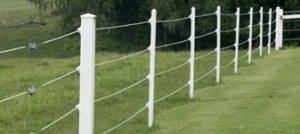Horse Fences: Build the Ideal Enclosure
 Horses, unlike other livestock, will require well-structured and pre-planned fences to keep them enclosed, but more importantly, keep them safe. Even small animals, like dogs and cats, can startle a horse and cause it to flee. When a fence is poorly built, a horse can get hurt–but so can your wallet.
Horses, unlike other livestock, will require well-structured and pre-planned fences to keep them enclosed, but more importantly, keep them safe. Even small animals, like dogs and cats, can startle a horse and cause it to flee. When a fence is poorly built, a horse can get hurt–but so can your wallet.
Visible, But With Enough “Give”
According to Pennsylvania State University, horses are far-sighted and are accustomed to using the horizon to look for eminent danger. When a fence is high and visible enough, a horse can spot it, slow down and prevent running into it. But in some instances, a horse will run into a fence at full steam, requiring planners and builders to allow enough “give” to prevent a horse from causing itself harm. The added “give” creates a bit of wiggle room for a fence. When a horse batters a fence, the posting moves slightly to lessen the impact on a horse’s head or body.
High Enough, With No Openings
Stallions like to jump, and high enough fences discourage an animal from hopping over a fence with ease. Ideally, a fence should measure around 54 to 60 inches above the ground to prevent any attempts to jump over. More importantly, the height will add to the visibility of an enclosure to keep an animal from testing its strength on a fence. Good horse fencing attributes also allow for no openings that can possible trap a horse’s head or body. Fences with few openings too keep smaller animals—cats and dogs—from randomly walking into an enclosure and scaring a horse.
No Leaning, But Keep Proper Space Rails
Horses tend to lean on a fence, testing its strength, and a fence that prevents leaning provides the safest approach. Meanwhile, when space rails are in place, planners should allow for no more than 12 inches of opening. If, for example, you use a gallagher fence, the electric fencing should allow for no more than 18 inches of spacing to better protect an animal.
Driven Posts
Finally, quality fences almost always use driven posts to secure fencing rather than pre-drilled holes. Driven posts are created using specialized equipment that drives wood into the ground, keeping material secured. And compared to pre-drilled holes, driven posts will always require assistance to install because of the equipment required. These heavy pieces of machinery require trained experts, but the added cost creates a sturdy, long-lasting fence to keep your horses safe.
————————————————————————————
Jason Governo writes on behalf of the Farm Supply Store, the Web’s one-stop shop for farm and garden fencing.

